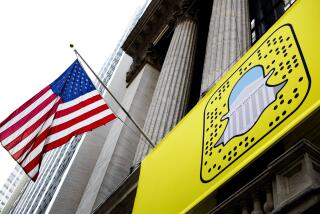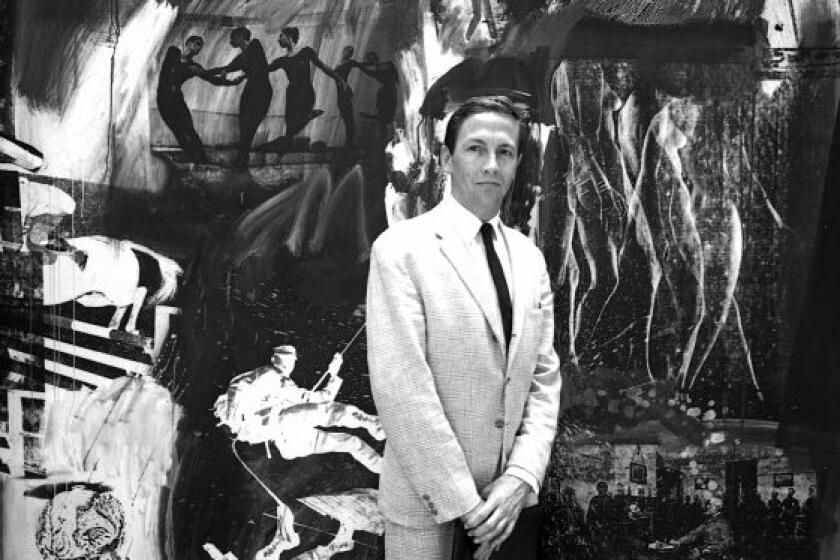Carlsbad’s Public-Art Exhibit Stresses Variety, Quantity
The third time is the charm for Carlsbad’s annual temporary public-art exhibition.
In both of the city’s previous efforts, free-lance curators for the shows put a premium on variety and quantity, but not necessarily on substance. There were a few exceptions, even a dip or two into social criticism, but a tone of decorative appeasement prevailed.
Perhaps the curators were gun-shy. After all, public art has had a bad name in San Diego in the last few years, since three promising public art proposals were rejected by city port commissioners whose narrow scope, they claimed, reflected the city’s own character and desires.
Carlsbad’s program was well-intentioned from the start. It aimed to ease its citizens gently into the notion of public art by keeping it obvious and temporary. Consequently, however, most of the two or three dozen works in the previous shows stood on their sites with all the awkwardness of short-term guests--conspicuous and loud.
This year’s selection differs substantially from the past. The best of the five works fit snugly into their chosen sites, adding vital new dialogue without rudely interrupting the old. They announce themselves slowly, quietly, subtly. Their presence may even go undetected by some; others will glean their insights during a gradual discovery, but few will glance and walk away.
Katya Williamson, a staff member in the Carlsbad Arts Office, made the selections this year. Working with a committee, she chose six artists (two working as a team) from Southern California and invited their responses to particular sites. This marks a significant change in tactic from previous years, when most of the work shown was pre-existing and simply plopped onto its site, welcoming or not.
Another factor adding cohesion to this year’s show is its thematic focus. Williamson encouraged the artists to create work that addressed the city’s identity.
Only one of the artists succumbed to reiterating the charms of Carlsbad’s appealing surface. Raul Guerrero, a prominent local artist known for more penetrating forays into the surreal, conceptual and psychological, opted here for simple decoration. His colored tile image of fish, starfish, water and sand covers the seat and seat back of a concrete bench overlooking the ocean (Carlsbad Blvd., between Sycamore and Chestnut Sts.). Guerrero suggests, through a statement posted nearby, that the image refers to both natural history and human evolution, but visually, it is little more than a cliche.
The four remaining artworks focus on Carlsbad’s history, especially the central role water has played in that history. As Joyce Cutler-Shaw’s “Carlsbad Water Stories” (Magee Park, Carlsbad Boulevard and Beech Street) explains, the city was named after the Bohemian well famous for its healing mineral waters.
In a series of 20 wood panels set into the park’s thick grass, Cutler-Shaw contrasts a respect for the water, especially on the part of the native Indian population, with a more contemporary, cavalier attitude toward it. Succinct and poetic, the tales are burned into the wood in English, Spanish, and the San Diego artist’s own “Alphabet of Bones.”
The progression of panels ends at a restored, 19th-Century cistern. It stands as a reminder from the past of the essential nature of water, while Cutler-Shaw’s words serve as a warning for the future: “The water speaks/The water says you can use me/But you can’t overcome me/You lead me out of my springs/You lead me from my rivers/But I come from the ocean/And I shall go back into the ocean/When I am out of sight I am on my way home.”
Anne Mudge’s “Memory” (Stagecoach Park, 3420 Caminito de los Coches) also mourns the smothering of Carlsbad’s natural resources by development and ignorance. It tries to restore the song of the park’s underground stream by planting “sound tubes” in a built, grassy mound above it.
Mudge, a local sculptor whose work is also currently on view at the San Diego Museum of Contemporary Art, wants park-goers to put their ear to a tube and listen to the sound of the buried stream, but she has made that act as awkward as possible by placing the tubes too high on the mound to be reached with ease. Clumsy and unsatisfying, “Memory” never does communicate the “ancient song” of Mudge’s accompanying poem.
Reaching further back and with far more grace into collective memory is the work of Jim Wilstermann and Machi Uchida (Stagecoach Park). The artists, both San Diego residents, incised different symbols for water on boulders that line the park’s feeble, cement-bottomed creek.
Wavy lines suggesting water or snakes, a small grid pattern, a target and other markings from old and new Indian, Japanese, Zodiac, cartographic and scientific vocabularies appear on rocks interspersed along the length of the creek. The “Ten Thousand Year Trail” whispers to passers-by in a primal tongue, one that encompasses both social and natural history.
Noel Korten, the only Los Angeles artist of the group, practices a similar, interventionist approach. His “Shedding Light Upon the Waters” (Magee Park) presents only a subtle change in the pre-existing environment, but is capable of evoking a much richer, deeper impression in the mind of the viewer.
Korten has placed several round, brass plates on the outside walls of the Magee barn, one of several historic structures in the park. Words, stamped in a spiral on the plate, encircle a small eyehole that affords a fish-eye view of a photographic montage within. One, for instance, describes the courtship of Florence Shipley and Hugh Magee, early settlers on the site. They met while riding horses, the text on the plate reads, and they married against the will of her father, whom she never saw again. The image within echoes the poignancy of the tale. It humanizes the site in a way that historical plaques simply can’t.
Another of Korten’s works contrasts an 18th-Century description of the Carlsbad landscape with an image of its present state, dotted with ubiquitous, Spanish-tile-roofed housing developments.
Korten, Cutler-Shaw, Wilstermann and Uchida introduce a new level of sophistication into Carlsbad’s temporary public art program. Their works never compete with their sites, but merge with them. They are full of insights and questions; they reward the visitor with an inquiring eye and sense of discovery.
The show is scheduled to end Aug. 2, but these enriching works deserve permanent status. Members of the Carlsbad Arts Office will be meeting soon to consider it.
More to Read
The biggest entertainment stories
Get our big stories about Hollywood, film, television, music, arts, culture and more right in your inbox as soon as they publish.
You may occasionally receive promotional content from the Los Angeles Times.






